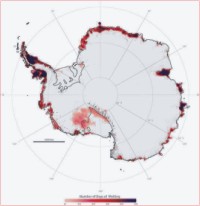Science
NASA: Antarctic Snowmelt Increasing
Andrea Thompson Live/Science Staff Writer
 Antarctic snow has been melting farther inland and at higher altitudes over the past 20 years, NASA scientists announced today. Antarctic snow has been melting farther inland and at higher altitudes over the past 20 years, NASA scientists announced today.
With a surface size about 1.5 times the size of the United States, Antarctica contains 90 percent of the Earth's fresh water, making it the largest potential source of sea level rise from global warming. The water at the bottom of the world is, of course, frozen.
Unlike the well-documented and rapid Arctic meltdown, snow melt in Antarctica has been very limited because even summer temperatures rarely rise above freezing.
But satellite data collected between 1987 and 2006 showed snowmelt in some unlikely places in 2005as far inland as 500 miles from the coast and as high as 1.2 miles above sea level in the Transantarctic Mountains. This data record, longer than those previously studied, provides confirmation of earlier reports of unusual melting in 2005.
The data also showed increased persistent snowmelt on the Ross Ice Shelf, in terms of both the area affected and the duration of the melt. (Persistent snowmelt is defined as melting that occurs for at least three days or for one consecutive day and night.)
The NASA scientists who examined the data suspect that Earth's rising temperatures may be to blame for the unusual melting patterns.
"Snow melting is very connected to surface temperature change, so it's likely warmer temperatures are at the root of what we've observed in Antarctica," said study leader Marco Tedesco of NASA's Goddard Space Flight Center in Greenbelt, Md.
The researchers did observe less snowmelt in some places during the 20-year period, but the increased melt in places like the Ross Ice Shelf is worrying because it can lead to melt ponds, which pool on the surface of the ice, and can fill small cracks in the ice, putting pressure on them and causing larger fractures in the ice.
"Persistent melting on the Ross Ice Shelf is something we should not lose sight of because of the ice shelf's role as a 'brake' system' for glaciers," Tedesco said.
"Ice shelves are thick ice masses covering coastal land with extended areas that float on the sea, keeping warmer marine air at a distance from glaciers and preventing a greater acceleration of melting."
| 